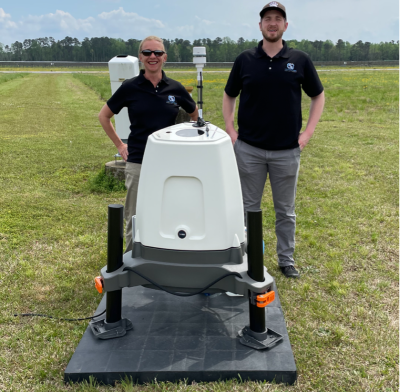June 1, 2023 | by NRG Team Voices | Engineering + Technology, NRG Stories

Annie Wright and Sam Tinnesz of TruWeather Solutions.
NRG Systems recently worked with TruWeather Solutions, a micro weather analytics and technology company based in Reston, Virginia, to provide Washington-Warren Airport (OCW) with a ZX 300 Lidar. The vertical profiling Lidar captures wind measurements from 10 to 300 meters and will ensure the safe and reliable integration of unmanned aircraft systems (UAS) into the manned airspace around the North Carolina facility. OCW is now the first General Aviation airport, and the only airport east of the Appalachians, to provide this technology for drone, eVTOL, helicopter, and small aircraft customers.
Installing the ZX 300 at OCW was part of an undertaking spearheaded by OCW and XElevate to develop a UAS Center of Excellence at the airport. Prior to the endeavor at OCW, XElevate, which is based in Leesburg, Virginia, was the first and only UAS Center of Excellence in the region. OCW is now on its way to becoming the first Drone-Smart airport on the East Coast, providing a framework for other airports looking to integrate unmanned flight operations into national airspace safely and at scale.
We spoke with TruWeather Solutions about this landmark project as well as Lidar’s role in the rapidly growing UAS sector.
NRG Systems (NRG): Can you tell us about TruWeather Solutions’ role in the OCW project?
TruWeather Solutions (TWS): TWS and XElevate have an ongoing partnership and a history of collaborating on projects that improve weather data and infrastructure to enable the safe expansion of drones and helicopters into integrated airspace. For this particular project, TWS provided our V360 weather application, the ZX 300, which we acquired from NRG Systems, and various other sensors. We also provide ongoing client and forecaster support.
NRG: How did you land on NRG and ZX 300 for this project? How did this technology fit into the overall scope?
TWS: We chose NRG due to our long-standing professional respect for the quality of not only the ZX 300 Lidar technology, but the personnel at NRG. Our goal in acquiring the ZX 300 was to enhance our understanding of low-level winds and take that rare, virtually non-existent data, and apply it to increase the flight time, safety, and efficiency of operations of all aircraft that utilize Washington-Warren Airport.
In addition, TWS has installed various weather sensors around the airfield, to complement OCW’s Automated Surface Observing System. We will be using the ZX 300 to validate other sensor types for future consideration. We also intend to use the data provided by ZX 300 to learn much more about the intercoastal waterway’s effects on winds as well as the local micro-scale topographical features, helping us to identify trends that will allow us to forecast more accurately.
NRG: What were some of the biggest challenges faced during this project?
TWS: This was TruWeather Solutions’ first time installing this particular Lidar, the first-ever installation at a municipal airport, and the only active airport Lidar on the East Coast. Our main challenge was getting a site that allowed the ZX 300 to operate to its full potential and laying out the power and communications requirements. Once we had that established, NRG’s on-site training made the remainder of the project not only seamless, but enjoyable.
NRG: With the ZX 300 installed, how has the technology impacted flight operations?
TWS: We have already identified multiple days where the actual winds from surface-to-1000ft deviated from even the highest resolution weather model currently running in the United States. We will be using the data provided by ZX 300 to make actual go/no-go decisions on drone flights, and to continue to adjust our forecasts when the actual winds deviate from the models.
NRG: What role do you think Lidar technology will play in the future of flight and UAS integration?
TWS: After installing the ZX 300 and watching the data for the past several weeks, I would consider it a must-have sensor for any airport, company or operation that has the means and the desire to know and study micro-scale, low level winds, particularly the drone and eVTOL industries.
To learn more about ZX 300 and its ability minimize risk and improve outcomes across various applications, sales@nrgsystems.com.

